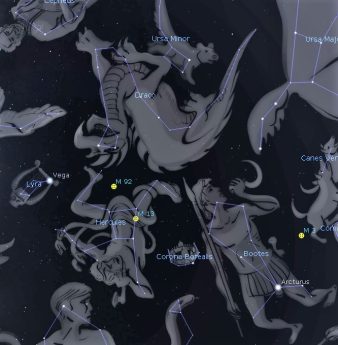This Week’s Sky at a Glance, 2025 July 19 – Ju1y 26
This Week’s Sky at a Glance, 2025 July 19 – Ju1y 26
Stargazers prefer meridian observing because that is when we should have our best views of objects in a telescope or binoculars. The meridian is the imaginary line running from north to south, separating the sky into eastern and western hemispheres. When stars and planets cross the meridian they are at their highest, shining through a minimal thickness of atmosphere en route to our eyes. Unstable pockets of atmosphere will distort the light from stars and planets and blur the view, so minimal atmosphere means less distortion. Astronomers use the term “seeing” to describe the steadiness of the atmosphere. Good seeing means steady air and we can use higher magnification for observing details of the Moon and planets.
Around 10 pm this week we have several prominent constellations near the meridian. Moving southward from the North Star we have Ursa Minor or the Little Dipper. A small telescope with good seeing conditions will show the close companion star of Polaris, which is actually a triple star although only two of them can be seen in a telescope. Heading southward we pass through Draco the Dragon on our way to Hercules. The faintest of the four stars in the dragon’s head is an easy double star to resolve in binoculars. The globular cluster M92 is about halfway between the head and the Keystone asterism of Hercules, and don’t forget M13 along the western side of the Keystone.
Hercules goes head-to-head with Ophiuchus to its south, which contains a several globular clusters itself. Ophiuchus stands on Scorpius, keeping the scorpion underfoot so that it cannot fatally sting Orion again. Scorpius at the meridian is the best time to observe globular clusters M4 and M80, and open clusters M6 and M7.
This Week in the Solar System
Saturday’s sunrise in Moncton is at 5:47 and sunset will occur at 9:03, giving 15 hours, 16 minutes of daylight (5:55 and 9:05 in Saint John). Next Saturday the Sun will rise at 5:54 and set at 8:56, giving 15 hours, 2 minutes of daylight (6:02 and 8:58 in Saint John).
The Moon is near the Pleiades Sunday morning and the waning crescent slides over Venus and Jupiter before reaching the new phase on Thursday. Saturn is now rising before midnight, Venus rises around 3 am, and Jupiter rolls out of bed before 4:30. Mars continues to hang out low in the west in the evening and setting around 11 pm. Mercury is too close to the Sun for observing.
Summer star parties in the major parks are scheduled for July 25-26 at Mactaquac, August 1-2 at Mount Carleton, August 22-23 at Fundy, and September 13-14 at Kouchibouguac. See rascnb.ca for details.

